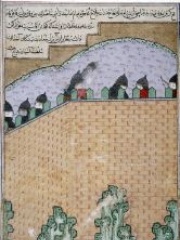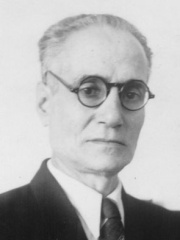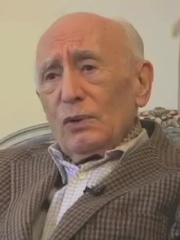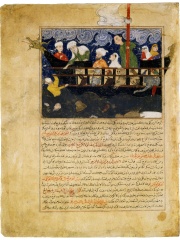





The Most Famous
HISTORIANS from Iran
This page contains a list of the greatest Iranian Historians. The pantheon dataset contains 561 Historians, 7 of which were born in Iran. This makes Iran the birth place of the 16th most number of Historians behind Netherlands, and Spain.
Top 7
The following people are considered by Pantheon to be the most legendary Iranian Historians of all time. This list of famous Iranian Historians is sorted by HPI (Historical Popularity Index), a metric that aggregates information on a biography's online popularity.

1. Abu al-Faraj al-Isfahani (897 - 967)
With an HPI of 67.16, Abu al-Faraj al-Isfahani is the most famous Iranian Historian. His biography has been translated into 35 different languages on wikipedia.
Ali ibn al-Husayn al-Iṣfahānī (Arabic: أبو الفرج الأصفهاني), also known as Abul-Faraj, (full form: Abū al-Faraj ʿAlī ibn al-Ḥusayn ibn Muḥammad ibn Aḥmad ibn al-Ḥaytham al-Umawī al-Marwānī al-Iṣfahānī) (897–967CE / 284–356AH) was a writer, historian, genealogist, poet, musicologist and scribe. He was of Arab-Quraysh origin and mainly based in Baghdad. He is best known as the author of Kitab al-Aghani ("The Book of Songs"), which includes information about the earliest attested periods of Arabic music (from the seventh to the ninth centuries) and the lives of poets and musicians from the pre-Islamic period to al-Isfahani's time. Given his contribution to the documentation of the history of Arabic music, al-Isfahani is characterised by George Sawa as "a true prophet of modern ethnomusicology".

2. Ibn al-Faqih (b. 0)
With an HPI of 62.50, Ibn al-Faqih is the 2nd most famous Iranian Historian. His biography has been translated into 26 different languages.
Aḥmad ibn Muḥammad ibn al-Faqih al-Hamadani (Persian: احمد بن محمد ابن فقيه همدانی) (fl. 902) was a 10th-century Persian historian and geographer, famous for his Mukhtasar Kitab al-Buldan ("Concise Book of Lands") written in Arabic. In the 1870s the Dutch orientalist Michael Jan de Goeje edited a selection of geography works of Arab geographers in an eight-volume series titled Bibliotheca geographorum Arabicorum published by Lugduni-Batavae (Leiden) Brill publishers. Al-Hamadhānī's Mukhtasar Kitab al-Buldan was published in volume 5 of this series. In 1967 second editions were printed by Dar Sadir (Beirut) and E.J. Brill (Lugduni Batavorum).

3. Sharaf al-Din Ali Yazdi (1500 - 1454)
With an HPI of 60.54, Sharaf al-Din Ali Yazdi is the 3rd most famous Iranian Historian. His biography has been translated into 16 different languages.
Sharaf ad-Din Ali Yazdi or Sharif al-Din Ali’ Yazdi (Persian: شرف الدین علی یزدی; died 1454, Yazd), also known by his pen name Sharaf, was a 15th-century Persian scholar who authored several works in the arts and sciences, including mathematics, astronomy, enigma, literature such as poetry, and history. The Zafarnama, a life of Timur, is his most famous work. Sharif al-Din was born in the city of Yazd, Iran in the 1370s. He devoted much of his life to scholarship, furthering his education in Syria and Egypt until Timur's death in 1405. As a young man, he was a teacher in his native city of Yazd and a close companion of the Timurid ruler Shahrukh (1405–47) and his son Ibrahim Sultan. In 1442/43 he became the close advisor of the governor of Iraq, Mirza Sultan Muhammad, who lived in the city of Qom. Sharif al-Din rebelled against Shahrukh Timur in 1446/47 when the government was vulnerable, but was later sent to different cities for his acumen. The later years of his life were spent in Taft, where he died in 1454. Sharif al-Din was directed to write a biography of Timur in 1421 known as the Zafarnama, which he completed four years later in 1425. Timur's grandson Sultan Abu al-Fath Ibrahim Mirza was Sharif al-Din's patron during the completion of his grandfather's biography.

4. Ahmad Kasravi (1890 - 1946)
With an HPI of 59.84, Ahmad Kasravi is the 4th most famous Iranian Historian. His biography has been translated into 25 different languages.
Ahmad Hokmabadi Tabrizi (29 September 1890 – 11 March 1946), later known as Ahmad Kasravi, was a pre-eminent Iranian historian, jurist, linguist, theologian, a staunch secularist and intellectual. He was a professor of law at the University of Tehran, as well as an attorney and judge in Tehran, Iran. Born in Hokmavar (Hokmabad), Tabriz, Iran, Kasravi was an Iranian Azerbaijani. During his early years, Kasravi enrolled in a seminary. Later, he joined the Iranian Constitutional Revolution. He deserted his clerical training after this event and enrolled in the American Memorial School of Tabriz. Thenceforward he became, in Roy Mottahedeh's words, "a true anti-cleric." Kasravi was the founder of a political-social movement whose goal was to build an Iranian secular identity. The movement was formed during the Pahlavi era. Kasravi authored more than 70 books, mostly in the Persian language. The most important book from his body of work are History of the Iranian Constitutional Revolution, Azari or the Ancient Language of Azerbaijan and The 18 Year History of Azerbaijan. He was attacked vehemently by the Shi'ite clergy for his secular ideas and by the Pahlavi court for his anti-monarchical statements. In his early period he was linked with the Democrat Party in Iran. In 1941 he established a political party, Azadegan. Kasravi was eventually assassinated by followers of Navvab Safavi, the founder of the Shi'ite fundamentalist Fada'iyan-e Islam group. Many of the prominent members of the then Iranian clergy, including the later Ayatollah Ruhollah Khomeini, supported the act of Kasravi being murdered, and Navvab and the Fada'iyan were proclaimed heroes following the assassination. Kasravi was the first Iranian Azerbaijani intellectual to take a firm position against pan-Turkists from the Ottoman Empire, and authored the most important work on the Iranian identity of the Azerbaijan region and the region's Old Azeri language, an Iranian language. Kasravi is widely despised by pan-Turkists in the Republic of Azerbaijan and Iran, who view him as a "traitor" to Azerbaijanis.

5. Hafiz-i Abru (0 - 1430)
With an HPI of 57.69, Hafiz-i Abru is the 5th most famous Iranian Historian. His biography has been translated into 18 different languages.
Hafez-e Abru (Persian: حافظ ابرو; died June 1430) was a Persian historian working at the courts of Timurid rulers of Central Asia. His full name is ʿAbdallah (or Nur-Allah) Ebn Lotf-Allah Ebn 'Abd-al-Rashid Behdadini; his short name is also transcribed in Western literature as Hafiz-i Abru, Hafez-e Abru, Hafiz Abru etc. Hafiz-i Abru was born in Khorasan and studied in Hamadān. He entered Timur's court in the 1380s; after the death of Timur, Hafiz-i Abru continued in the service of Timur's son, Shah Rukh, in Herat. He interacted with other scholars congregating around Timur's and Shah Rukh's courts, and became recognized as a good chess player. Hafiz-i Abru is the author and/or compiler of numerous works on the history and geography of the Timurid state and adjacent regions, commissioned by his master Shah Rukh, in particular Majma al-tawarikh ("World Histories").

6. Ehsan Yarshater (1920 - 2018)
With an HPI of 56.67, Ehsan Yarshater is the 6th most famous Iranian Historian. His biography has been translated into 21 different languages.
Ehsan Yarshater (Persian: احسان يارشاطر; April 3, 1920 – September 1, 2018) was an Iranian historian and linguist who specialized in Iranology. He was the founder and director of the Center for Iranian Studies, and Hagop Kevorkian Professor Emeritus of Iranian Studies at Columbia University. He was the first Persian full-time professor at a U.S. university since World War II. He was one of the 40 editors of the Encyclopædia Iranica, with articles by 300 authors from various academic institutions. He also edited the third volume of The Cambridge History of Iran, comprising the history of the Seleucids, the Parthians, and the Sassanians, and a volume entitled Persian Literature. He was also an editor of a sixteen-volume series named History of Persian Literature. He had won several international awards for scholarship, including a UNESCO award in 1959, and the Giorgio Levi Della Vida Medal for Achievement in Islamic Studies from UCLA in 1991. Lecture series in his name have been instituted at the University of London, the University of California, Los Angeles, and the Centre National de Recherche Scientifique in Paris.

7. Firishta (1560 - 1620)
With an HPI of 53.15, Firishta is the 7th most famous Iranian Historian. His biography has been translated into 17 different languages.
Firishta or Ferešte (Persian: فرشته), full name Muhammad Qasim Hindu Shah Astarabadi (Persian: محمدقاسم هندوشاہ استرابادی), was a Persian historian, who later settled in India and served the Deccan Sultans as their court historian. He was born in 1570 and died between 1611 and 1623.
People
Pantheon has 7 people classified as Iranian historians born between 897 and 1920. Of these 7, none of them are still alive today. The most famous deceased Iranian historians include Abu al-Faraj al-Isfahani, Ibn al-Faqih, and Sharaf al-Din Ali Yazdi.
Deceased Iranian Historians
Go to all RankingsAbu al-Faraj al-Isfahani
897 - 967
HPI: 67.16
Ibn al-Faqih
HPI: 62.50
Sharaf al-Din Ali Yazdi
1500 - 1454
HPI: 60.54
Ahmad Kasravi
1890 - 1946
HPI: 59.84
Hafiz-i Abru
HPI: 57.69
Ehsan Yarshater
1920 - 2018
HPI: 56.67
Firishta
1560 - 1620
HPI: 53.15

